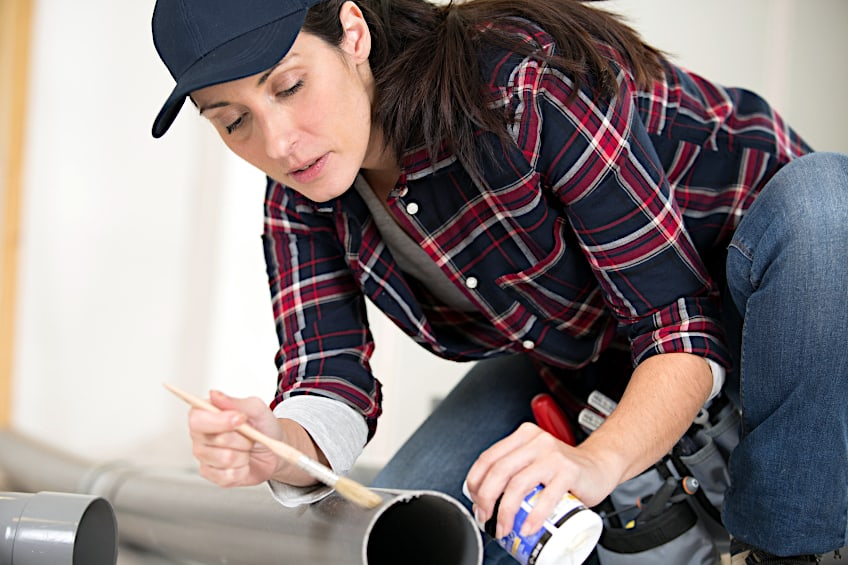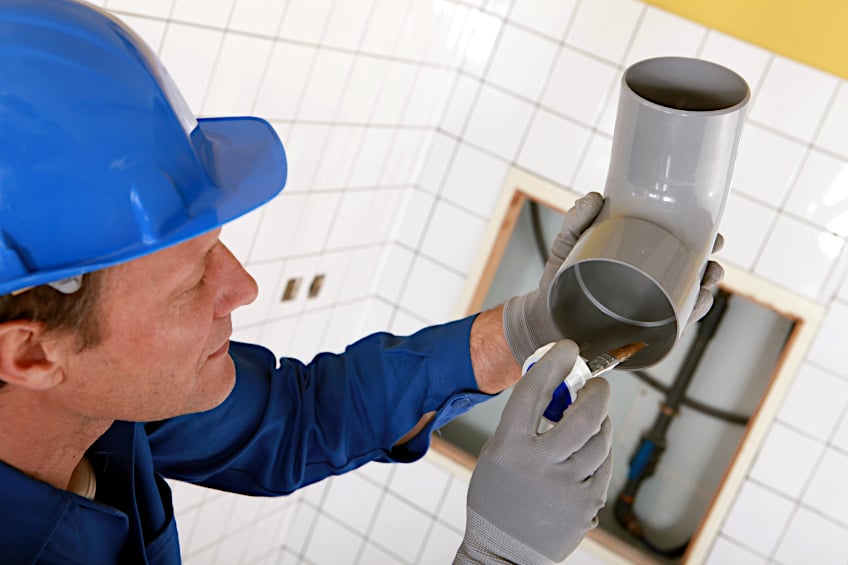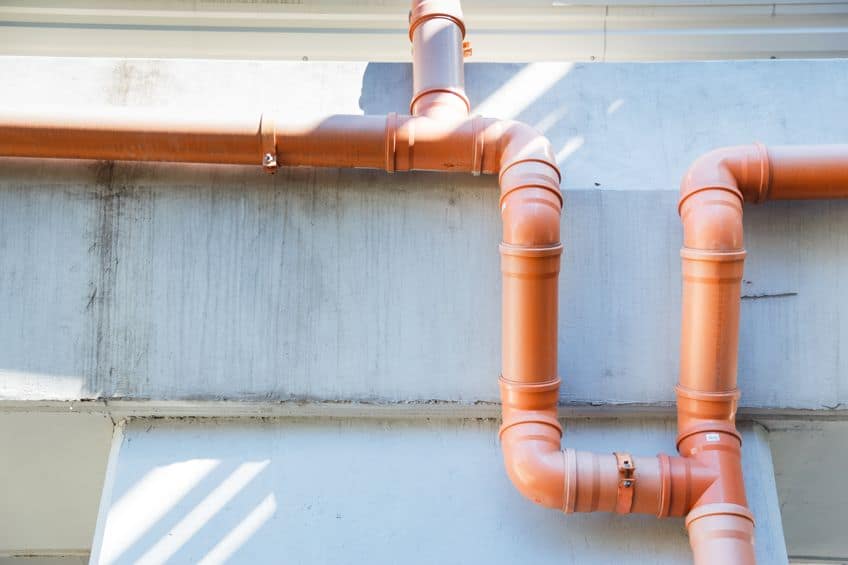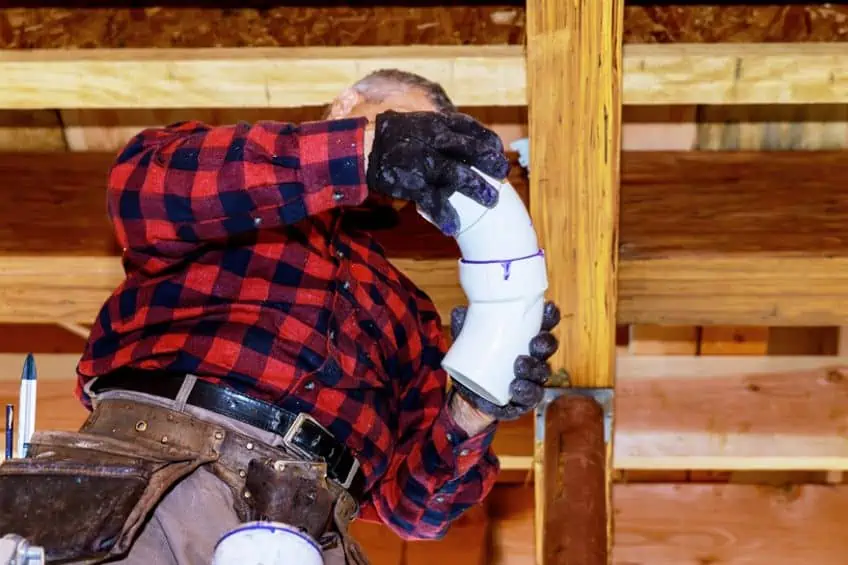How to Glue PVC Pipe – Best Adhesives for Thermoplastics
This post may contain affiliate links. We may earn a small commission from purchases made through them, at no additional cost to you.
Polyvinyl chloride is a thermoplastic that is well-known for its usage in PVC pipes, which is utilized for a number of purposes, ranging from domestic to commercial, as well as in handicraft. The substance is inexpensive and simple to cut, and it can be put together in minutes to form a lasting connection. A PVC pipe seal is necessary to form this bond, thus you will need to understand how to connect PVC pipe utilizing PVC pipe glue.
Table of Contents
The Various Kinds of PVC Pipes
There are three major varieties of PVC that all fall under the PVC umbrella for plastic pipes. The first is polyvinyl chloride, and the second is CPVC, both of which are chemically identical. The major distinction is how they respond to heat; CPVC can endure far greater temperatures than PVC, is more commonly used in commercial applications, and is more costly. PVC pipe includes two additional specialist or altered PVC products: PVC-U, which really is unplasticized PVC, PVC-O, which increases the advantages of PVC-U, and PVC-High, which is a higher intensity grade choice.

The last kind is ABS, but it has an entirely unique makeup. It is known as an opaque thermoplastic polymer that is often used in the injection molding process. Many people use the phrase PVC glue, which might include superglue; nevertheless, cement is required to firmly join two pieces of PVC material. PVC cement produces a chemical link between the two components, whereas glue just makes a bond. You may use glue on PVC, but only for art projects or less rigorous purposes. Here are the four main kinds of PVC used for pipes:
| Type of PVC | Uses |
| Unplasticized PVC (PVC-U)
| Industrial drainage, pipes, fittings, sewerage, drinking water, and soil transportation |
| Chlorinated PVC (C-PVC)
| Industrial liquids, pipes, fittings, drinking water transportation |
| Molecular-Oriented PVC (PVC-O)
| High-pressure pipes and fittings, sewerage pump mains, irrigation |
| High Impact PVC (PVC-Hi)
| High-temperature use, industrial liquids, commercial sewerage |
PVC Cement (Polyvinyl Chloride)
This cement is designed for PVC pipes in the 40 and 80 schedules. The thinner walls of the lower schedule can only sustain lesser water pressures, but the stronger walls of schedule 80 can be utilized in industrial uses. When applied to the pipe, the surfaces soften and then harden due to the formation of a permanent connection or bond. Among some of the uses are sewers and plumbing pipelines, as well as cable insulation.

Color Coded PVC Cement
When searching for PVC cement, you may notice that goods are branded in a variety of colors. The sort of cement required is determined by the purpose. For instance, transition cement is branded green, whereas rapid setting cement is designated blue, aqua blue may be employed in water or in moist situations, and orange is for colder climates applications. Yellow is a one-step CPVC cement that does not involve priming. It is, nevertheless, always preferable to use a primer, which we shall go over further in this post.

ABS Cement (Acrylonitrile Butadiene Styrene)
ABS cement is designed specifically for use on ABS pipes. Other PVC kinds cannot be treated with cement. ABS pipe is widely utilized in drainage, waste, and vent applications. The sort of cement you choose is critical because you don’t want pipe joints to deteriorate or explode.

Transition Types of Cement
To bond different types of PVC pipe, such as PVC to ABS, transition or general-purpose cement can be utilized. The various pipes are linked without causing a violent chemical reaction that emits harmful gases.

CPVC Cement (Chlorinated Polyvinyl Chloride)
For changes in temperature, CPVC cement will be more efficient than cheaper PVC cement in order to be successful. You will see that CPVC will be printed on the label of items. When buying, always pay attention to the texture, since if it has thickened, it indicates that something is wrong and it will not bind correctly.

A Guide on How to Glue PVC Pipe
Because PVC is an ultra-light yet long-lasting substance, it is frequently used for agriculture, pipework, and wastewater. Pipes are typically white or slightly off-white in color, and PVC joints are made with solvent cement or fittings, based on the substance and uses. PVC drain pipes are popular for domestic usage since they are inexpensive and simple to install. Damaged pipes should be readily repaired, however, there are situations when a portion of piping must be changed.

When it comes to bonding PVC, you’ll need a specialized primer and cement. The solvent cement will make a permanent link by forming a chemical process that softens and rehardens the surfaces, fusing or ‘soldering’ the two PVC pieces permanently. This will result in an airtight, leak-proof enclosure.
The Use of PVC Primers
Is a primer required when installing a PVC pipe seal? Most of the time, a primer is required before utilizing PVC pipe cement. The primer cleanses the surface, washes it, and aids in the bonding process. In some circumstances, instead of PVC pipe cement, a mechanical connection is required. When joining a PVC and ABS plastic pipe, for instance. A medium-bodied primer is ideal for schedule 40 PVC pipe; nevertheless, a heavy-duty body primer is advised for bigger diameter fittings such as schedule 40, schedule 80 PVC piping, and CPVC plumbing. The primer is placed outside around the border of the PVC pipe as well as on the interior side of the PVC joint or fittings when bonding PVC joints.

The PVC pipe cement is spread in the very same manner as the primer after a few seconds. The pipe is then inserted into the connection, and the cement is allowed to merge and join. There are two sorts, namely a heavy and medium body primer. The thick body primer is best suited for commercial processes and is more expensive. PVC primers are available in two colors: purple and clear. As the purple hue indicates, the purple primer is employed as a form of indicator.

This is important for industrial inspections since a visual examination is considerably simpler and faster to do. Clear primers are ideal for usage in the home, where you want everything to seem nice and tidy. Some solvent cement companies also provide a variety of alternatives, some of which do not require the use of solvents. For example, the Rain-R-Shine Medium Blue PVC Cement and the Oatey brand Hot Medium Blue Lava PVC Cement.
A Guide to Primer And PVC types
The chart below provides a quick overview of the various types of PVC that you’ll need to glue, as well as whether or not a primer is required.
| Type of PVC | Can a Primer Be Applied? |
| PVC | ✔ |
| CPVC | ✔ |
| PVC-U | ✔ |
| PVC-O | ✔ |
| PVC-High | ✔ |
| ABS Piping | ✘ |
How to Connect PVC Pipe
In some circumstances, simple PVC plumbing repairs may not be enough, and you will need to replace a portion. When working with water pipes, you must first turn off the water at the main supply before doing any adjustments. The first step is to gauge and cut the pipe to the proper dimensions. Dry fitting is usually suggested prior to beginning the bonding PVC pipe procedure. So, let us look at how to glue PVC pipes using these basic procedures.

Measuring and Cutting the PVC Pipe
Gathering all of your equipment and materials before starting any sort of repair task around the house will make things simpler and save you effort. Pre-cut PVC pieces should be available at a hardware shop, or you may buy and cut one yourself.
The following are some of the tools needed:
- PVC Piping
- Saw or Pipe Cutter
- Measurement Tape
- A vice
- 80-grit Sandpaper
To replace the damaged portion, use the cutter to cut roughly an inch on either side of the broken pipe. Measure how much pipe you’ll need to replace the broken pipe and mark it with a permanent marker. Place your pipe in the vice, align it with your indicated region, and cut it to the desired size. Refine the uneven cut corners using sandpaper.

How to Dry Fit the PVC Pieces
Dry-fitting your PVC components are suggested to prevent errors and ensure precision. This procedure will help guarantee accurate measurements and should be completed before firmly bonding the PVC components. You may make changes, obtain new PVC joints if necessary, and get everything looking the way you want it to. You may also note where PVC components must line and number the various pieces if necessary to fit all pieces in their right placements. When everything fits precisely, you can pull everything apart and begin gluing.

Setting It All Up
When attaching PVC, the cement emits an odor that might be harmful if it comes into direct contact with the face or eyes. Therefore, before you start, you must observe a few precautions. Wear gloves, safety goggles, and a face respirator. Nitrile gloves that can withstand abrasive substances should be used. Prepare all of your PVC pipes and joints ahead of time, and protect your workspace to safeguard the surfaces. Prepare your primer and cement for usage. You should also have some hand towels or cloths on hand to clean up any accidents or spills that may arise.

Gluing PVC Pipe
Check to make sure you’ve picked the right primer and cement for the project. Color codes and reading the label can help distinguish between the many varieties. Some cement glues, for example, can endure greater temperatures than others, while others can aid in the bonding of various polymers.
Next, prime the PVC surface, first on the exterior of the pipes and then on the inside edge of the fittings. We’ve discussed the many primers offered; if you use the purple primer, keep in mind that it might discolor surfaces. Because the primer is relatively thin, use caution while handling it. A priming paintbrush should be affixed to the inside of the primer cover. Lift out and brush your finger around the lip to eliminate any extra primer before applying to your surface.

Apply the primer, beginning at the end of the pipe and ending at the visible marking. Use only thin coats of primer to avoid dripping or pooling. The primer cures quickly and just takes a few seconds to dry, so you won’t have to wait long before applying the cement. Apply cement to the same places where the primer was placed. Make sure the area is completely coated with one coat.
Drying and Assembly
Join the two sections by sliding the pipe into the fitting and adjusting per the specifications you indicated. Hold the parts securely in position for 10 to 30 seconds to ensure that it all stays in position. Wipe removes any excess cement. It is preferable to wait around 15 minutes before touching the item, and it should be totally dry and bonded in two hours.

Proper Safety Precautions When Gluing PVC Pipes
Wear safety clothing when gluing PVC pipes and working with dangerous substances. You don’t want to inhale the vapors or get the substance on your eyes or skin. Also, avoid working in places with an open flame since the materials are flammable.
- Work in a well-ventilated area.
- A respirator mask is preferable to a dust mask.
- Wrap your workspace with a cloth to prevent it from dirt and stains. Glue may get messy and harm surfaces. The purple primer has the potential to discolor surfaces and is difficult to eliminate.
- The materials you’re working with might burn on skin contact. It is recommended to wear chemical-resistant nitrile gloves.

Tips and Tricks for Gluing PVC Pipe
Now that you’ve mastered the fundamentals of safety, there are a few tactics and ideas you may employ to produce the ideal PVC pipe seal. This is critical to create the greatest connection possible since you do not want any leaks to develop as a result of a poor job. So here are a few easy pointers to get you started.
- Be sure to keep the two components you’re attaching together for at least 10 seconds, otherwise, the air pressure will force them apart.
- It is preferable to use solvent cement rather than glue for domestic uses. The adhesive will not form a strong binding.
- A pipe cutter is an ideal option, although a flat-edge saw would suffice.
- Allow at least 24 hours for the linked pipework to harden before utilizing it.
- Smooth any cut edges before gluing; otherwise, the seal may be compromised or blockage may occur inside the pipe.
- Make sure you have the correct cement for the job.
- Because you must work quickly, have all of your ingredients and tools available before you begin gluing.
- When inserting the PVC pipe into the fitting, twist it slightly to disperse the adhesive and then line it properly with your marks.
- Purchase a few extra fittings just in the event they need to be replaced.
- Work fast yet precisely, avoiding drips and splashes.
After following this detailed guide, you should be completely prepared and knowledgeable on how to glue PVC pipes together on your own. You now know which PVC pipe glue is ideal for your project, whether it requires a primer, and how to connect PVC pipes. Also read through our plastic glue guide.
Frequently Asked Questions
Can One Connect CPVC Piping with PVC?
Yes, you certainly can. CPVC is more expensive than PVC and is generally used for specialized applications. Using PVC alone would provide the same advantages and would be less expensive.
Does One Need to Use a Primer with PVC Cement?
It is entirely up to you and the task at hand. Some people do not use a primer with cement adhesive, while others do. Primer isn’t always essential, but by using it, you’re creating a better and stronger connection that will help avoid leaks in the long term.
Are Glue and PVC Cement the Same Thing?
No, they are not the same. Glue and adhesives, such as superglue, just form a bind, whereas PVC cement creates a chemical reaction, often referred to as a solvent weld. This reaction melts the two surfaces together, resulting in a permanent connection.
What are PVC Pipes Used for?
Due to PVC being a lightweight yet long-lasting material, it is widely utilized in agriculture, pipes, and wastewater treatment. Pipes are usually white or slightly off-white in color, and PVC joints are created using solvent cement or fittings, depending on the composition and use. PVC drain pipes are popular for residential use since they are affordable and easy to install. Pipes that have been damaged should be easily repaired; nevertheless, there are times when a section of piping must be replaced. When it comes to bonding PVC, a specialized primer and cement are required.








